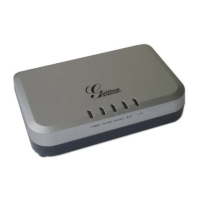Remove OBP from
Route Header
Default is No. When option YES is chosen, the Out Bound Proxy will be removed
from Route header.
Default is Yes. If set to Yes, the contact header in REGISTER request will
contain SIP
Instance ID as defined in IETF SIP Outbound draft.
Validate incoming
SIP message
Default is No. If set to yes all incoming SIP messages will be strictly validated
according to RFC rules. If message will not pass validation process, call will be
rejected.
Check SIP User ID
for incoming INVITE
Default is No. Check the incoming SIP User ID in Request URI. If they don’t
match, the call will be rejected. If this option is enabled, the device will not be
able to make direct IP calls.
Authenticate
incoming INVITE
Default is No. If set to Yes, device will challenge the incoming INVITE for the
Authenticate ID and Password with 401 Unauthorized.
Authenticate Server
Certificate Domain
Default is No. If set to Yes, device will check the server TLS certificate to ensure
that the Common Name matches the configured SIP server
Authenticate Server
Certificate Chain
Default is No. If set to Yes, device will check the server TLS certificate to ensure
that it is authorized by a known Certificate Authority
Uses the certificate for Authentication if “Check Domain Certificates” is set to
“Yes”
Allow Incoming SIP
Messages from SIP
Proxy Only
Default is No. Check the incoming SIP messages. If they don’t come from the
SIP proxy, they will be rejected. If this option is enabled, the device will not be
able to make direct IP calls.
If set to Default, it will only add Privacy or PPI header when special feature is
not Telkom SA or CBCOM.
If set to Default, it will only add Privacy or PPI header when special feature is

